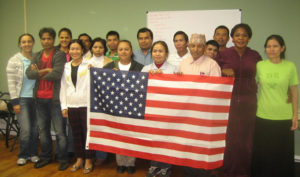Refugees give back more than they get – study
Refugees contribute more than they take in welfare over the long term, new research from the US shows.
A study recently published in America shows that refugees end up paying more in taxes than they receive in welfare benefits after just eight years of living in the US.
And by the time refugees who entered the US as adults have been there for 20 years, they will have paid, on average, $US21,000 more in taxes to all levels of government than they received in benefits over that time span.
 The figures come a working paper released this week by the US’ National Bureau of Economic Research.
The figures come a working paper released this week by the US’ National Bureau of Economic Research.
University of Notre Dame economist William Evans is co-author of the paper which examined the economic and social outcomes of refugees in the US.
“There is a lot of rhetoric saying these people cost too much, but we didn’t actually know what that number was,” Mr Evans said.
In January President Trump issued and executive order temporarily barring refugees from entering the US and he instructed the State Department to study the long-term costs of the refugee admissions program to federal, state and local government.
But Mr Evans and his colleagues responded first and modelled the economic impact of refugees.
They estimated that it costs the US an average of $15,000 to resettle each refugee, including the cost of background checks, housing, English lessons and job traning.
In addition, refugees, unlike other immigrants, are eligible for welfare cash assistance, food stamps and Medicaid.
Those social safety net costs amount to roughly $92,000 in benefits over a refugee’s first 20 years in the US – while the refugee pays a total of $129,000 in taxes over the same time period, researchers found.
Since the refugee admissions program started in 1975, the U.S. has resettled more than 3 million refugees. Researchers examined data pertaining to refugees from two dozen countries in Africa, Asia, Eastern Europe and the Middle East.
Despite arriving in the US country with significant language and educational barriers, refugees experience a rapid increase in employment rates and earnings over time, the study shows.
Outcomes are partly determined by whether the refugee arrived in the US as children, as teenagers or as adults.
Those who arrive before the age of 14 graduate from high school and enter college at the same rate as their locally-born counterparts, the researchers found.
But those who entered the country in their later teen years had lower educational achievements.
The researchers said the poorer outcomes were likely due to language barriers and the fact that many arrive unaccompanied by parents and end up in foster care.
Just five to 10 percent of children under the age of 14 arrive in the US without a mother. That figure increases to 20 to 30 percent for those arriving at ages 15 or 16. And more than 40 percent of refugees entering at age 17 come without their mothers.
Early employment and earnings outcomes and rely heavily on welfare programs, the research found.
But after six years in the US, refugees work at higher rates than their US-born counterparts — although their wages never catch up.
After 10 years, their use of welfare and food stamps are comparable to native-born Americans, the study found.
Mr Evans said the study showed refugees to have high levels of resilience.
“The conditions they experienced in the early part of their lives are pretty devastating. A lot of research has suggested that early life conditions make a huge difference in later life outcomes, but despite the poorer situations these children had early on, they seem to be doing pretty well,” he said.
“The longer refugees live in this country, the better their economic outcomes,” Mr Evans said.
Laurie Nowell
AMES Australia Senior Journalist












